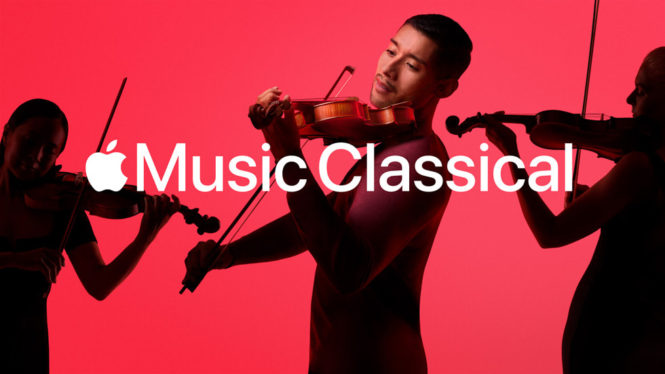Even if classical music made up just 1% of U.S. music consumption in 2022, according to Luminate, Apple’s new streaming service dedicated to the genre could mean big things for the subscription market.
Global recorded music revenues rose for the eighth straight year in 2022 — but markets are maturing, and the once high-flying growth rate fell to single digits. That doesn’t mean the music subscription business is getting stale, though. In fact, there are plenty of new ideas and much-needed innovations that can help push the streaming market forward.
The latest, and one of the best, examples of how the music business can build a better mousetrap is Apple Music Classical. Apple wanted to better serve classical music fans but realized the best path was to break away from the Apple Music subscription app that works fine for every other genre. So, it built Apple Music Classical, a standalone app for Apple’s iOS devices — the Android app will arrive later — that launched on Tuesday to some rave reviews (GQ called it “a ton of fun”).
Classical music has always been a second-class citizen in digital music because of the way its metadata — information about the recording — is organized. For most genres, describing music by artist, track and album is an adequate way to organize a massive number of recordings. Download stores and streaming services are built around this classification system. But since the advent of iTunes and download purchases, people have recognized that classical music doesn’t fit well in the standard metadata system. In classical music, music is better organized by such categories as conductor, orchestra and movement. This could help explain why classical music accounted for 2.7% of U.S. digital album sales but just 0.8% of on-demand streams in the U.S. last year, according to Luminate.
“It’s the works-based nature of classical,” says Dart Music founder Chris McMurtry, now a vp at Pex, a digital music rights company. “That’s why Apple had to build a separate app.” McMurtry addressed that problem at Dart Music, a digital distributor that focused on classical music and built a database with metadata fields better suited for the genre.
Apple wasn’t the first company to see an opportunity in classical music. Dart Music launched in 2015 to tackle the metadata angle (its assets were acquired in 2017 by Haawk), and classical-focused streaming isn’t new, either. Idagio debuted in 2015. Primephonic launched in 2019 and was acquired by Apple in 2021. Universal Music Group’s Deutsche Grammophon imprint debuted its own service, Stage+, in 2022.
But Apple’s entry into the classical music streaming market could be the most impactful to date. Apple has billions of customers around the globe and an increasingly successful services business that includes the Apple Music subscription app and Apple TV+, a streaming video-on-demand platform. Those cloud-based services, combined with Apple’s bread-and-butter business of selling smartphones and laptops, give the company the resources and marketing might to activate a passionate group of music aficionados that has been underserved by streaming platforms better suited for rock, pop and hip-hop.
“It exceeded my expectations,” says McMurtry, who looked up well-known names and obscure composers to appreciate the app’s level of detail. He says he was impressed by the depth of metadata — the producers, engineers, mixers, other contributors, year of the recording and even the composers’ birth and death years. “It’s a very educational experience.”
If Apple Music Classical can hook McMurtry, maybe it can lure more people into the music subscription market. In 2022, there were 92 million subscribers to streaming services such as Spotify, Apple Music and YouTube Music, according to the RIAA. In total, 214 million Americans — 75% of the population 12 and older — streamed music in the past month, according to a January 2023 survey by Edison Research. Younger consumers were far more likely to stream music than older listeners, however, with 53% of people over the age of 55 having done so compared to 89% of 12-to-34-year-olds and 85% of 35-to-54-year-olds. A good classical music app can help narrow that sizable gap, attract more subscribers and generate more subscription revenue.
Going after classical music fans makes financial sense, too. For starters, they’re plentiful, says Russ Crupnick, partner at market research firm MusicWatch. “By comparison, they are somewhat larger than the entire population of vinyl buyers,” he says. As older consumers, they can afford a standalone classical music app: Crupnick says classical music fans’ mean income is 35% higher than average. They’re also twice as likely to purchase expensive, audiophile stereo equipment. When asked if obtaining the highest-quality sound format is important, 64% of classical music fans said yes, and 54% are willing to pay more to get it. Fortunately for them, Apple Music Classical is free of charge to Apple Music subscribers. “It will be interesting to see whether Apple eventually adds fees to monetize the service, or subsidizes it as they have higher resolution audio,” says Crupnick.
There’s great potential outside of the United States, too. Apple Music Classical will eventually be available in three strong markets for classical music: Japan, China and South Korea. In China, the fifth-largest recorded music market in 2022, according to the IFPI, classical music has been a phenomenon since the Cultural Revolution. Gramophone magazine described it as a “gargantuan market for the consumption of recorded classical music even if only as a study aid or as a residue of having Mozart and Beethoven sonatas tinkling through the family home.”
The digital market has performed incredibly well without a mass appeal offering tailored for classical music fans. Record labels generated $16.9 billion from streaming in 2022 while mostly ignoring an important subset of the market. With Apple Music Classical, Idagio and Stage+ super-serving classical music fans, there’s potential to do better.
https://www.billboard.com/pro/apple-music-classical-app-good-streaming-business/





